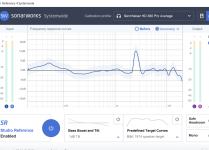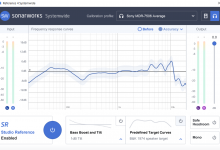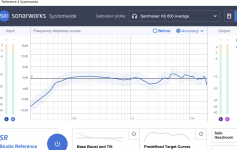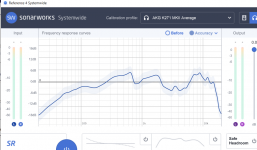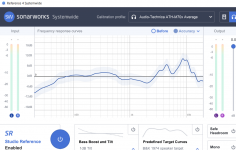Check out David Griesinger's headphone EQ stuff http://www.dgsonicfocus.com/
The website is quite a read but you can find about it from forums and Youtube as well by just Googling. Never tried it yet, just discovered. Seems reasonable since it takes account your hearing system as well while typical headphone EQ software like Sonarworks just equalizes the headphone.
That said I haven't listened to music with headphones for a while, speaker mucho better 🙂
The website is quite a read but you can find about it from forums and Youtube as well by just Googling. Never tried it yet, just discovered. Seems reasonable since it takes account your hearing system as well while typical headphone EQ software like Sonarworks just equalizes the headphone.
That said I haven't listened to music with headphones for a while, speaker mucho better 🙂
Fubar exists also for Android and Cromebook OS that one can install in old or new laptop/pc.Very light OS I didnt try it yet.
Cheers!
Cheers!
That is useful to know, thanks. With my limited skills with it I've found android quite awkward for a lot of things, partly also the hardware it typically comes on. But maybe chrome on a chromebook would help there, especially for small low-power or portable requirements.
Thanks! I'd not seen that page, or his work, before. Much reading to do, there and more generally, it seems.Check out David Griesinger's headphone EQ stuff http://www.dgsonicfocus.com/
The website is quite a read but you can find about it from forums and Youtube as well by just Googling. Never tried it yet, just discovered. Seems reasonable since it takes account your hearing system as well while typical headphone EQ software like Sonarworks just equalizes the headphone.
That said I haven't listened to music with headphones for a while, speaker mucho better 🙂
My most major take-home from this thread so far is that spatial placement (of the sound) is simply going to be an achilles heel for many/most headphones playing typical recordings. In fact whilst some 'phones might be slightly better (and so still worth pursuing), I'm concerned that many of the recommendations kindly made for higher quality equipment (including amps etc.) might not actually address it much at all. For me it seems very important for any sense of realism, so whilst other improvement in sound quality is of course no bad thing, it isn't actually going to help much by itself.
Therefore some other approach seems to be needed, instead or as well. On reflection it may very well be that this has to be something like DSP; I take the point higher up that the ideal solution would be recordings actually made for headphone playback, but unfortunately I need to listen to normal recordings and releases. So, it won't be as ideal but perhaps some kind of gentle processing at playback can help at least tweak or emphasise them acceptably towards better spatial placement on headphones - i.e. without sounding too artificial, which would defeat the object.
Cheers,
Kev
Last edited:
I have vinyl and i dont want to proces their Sound till i find very good solution. When it comes to allready digitized materiale Its different
Cheers!
Cheers!
Maybe stay away from old models headphones. Todays new models can give you amazing sind from 20dollars
Cheers!
Cheers!
Sure, all phones I've had access to are quite far from flat and some are more comfortable to wear than others etc. Very personal experience how it works with the head, ear and hearing system and application. I've got Sennheiser hd650 which are semi open with fine sound and quite comfortable to wear without eye glasses on, not comfortable with (working on computer). Then I have many closed back ~100€ closed back headphones like audiotechnica, sennheiser and beyerdynamic and they all are quite different sounding. Some are pleasing some not so, but all quite far from experience with proper speaker, there is no kick bass with cans for example. I'm not sure if any of my phones work with eye glasses, perhaps earbuds would be needed.
Anyway, for analog domain just test out many headphones and buy the ones that are most pleasing in all respects, there is no need for EQ correction for many models since they can be fine enough but perhaps all would benefit if there is possibility. Griesinger stuff could be tried with analog graphical EQ, plenty of them available second hand but not sure if this would be good or bad, perhaps bad phones would benefit and good ones not so much. Never tried the Griesinger stuff so, can't quite think what is the difference and how big it is.
I've got Sonarworks on computer and using the generic average corrections included give better sound with most the headphones I have, even the hd650 benefits I think. Here some screenshots for amusement. See for example the sennheiser hd380 pro, quite nice sub 100€ headphone otherwise except that +10db peak around 2kHz 😀 Or the Beats Pro with 12db bass boost, and whats wrong with the AKG? wild
Anyway, for analog domain just test out many headphones and buy the ones that are most pleasing in all respects, there is no need for EQ correction for many models since they can be fine enough but perhaps all would benefit if there is possibility. Griesinger stuff could be tried with analog graphical EQ, plenty of them available second hand but not sure if this would be good or bad, perhaps bad phones would benefit and good ones not so much. Never tried the Griesinger stuff so, can't quite think what is the difference and how big it is.
I've got Sonarworks on computer and using the generic average corrections included give better sound with most the headphones I have, even the hd650 benefits I think. Here some screenshots for amusement. See for example the sennheiser hd380 pro, quite nice sub 100€ headphone otherwise except that +10db peak around 2kHz 😀 Or the Beats Pro with 12db bass boost, and whats wrong with the AKG? wild
Attachments
Last edited:
Dr David Griesinger's website looks very interesting. Thanks for sharing.Check out David Griesinger's headphone EQ stuff http://www.dgsonicfocus.com/
The website is quite a read but you can find about it from forums and Youtube as well by just Googling. Never tried it yet, just discovered. Seems reasonable since it takes account your hearing system as well while typical headphone EQ software like Sonarworks just equalizes the headphone.
That said I haven't listened to music with headphones for a while, speaker mucho better 🙂
My diy journey started with building a simple 12AU7 headphone amp. A few months later after building xrk971’s (fantastic sounding) Pocket Class A headamp, member BYRTT introduced us to the “Harman target response curve” and he even shared EQ settings for specific headphone models, which I used with amazing results. So much to learn, so little time. You can read more about this here:
https://www.headphonesty.com/2020/0...iples that underpin both strands of research.
Thank you once again for the thoughts and info. Those are some quite illuminating graphs tmuikku, very interesting. Thanks also twocents for the harman curve link, that is a very good article; I will need to study it in order to comprehend many of the details properly, but it is clearly going to be very useful to my understanding. As you say; so much to learn, and indeed it isn't a quick process.
Cheers,
Kev
Cheers,
Kev
Hi all, it turns out headphones have their own Harman curve which looks like something like this:
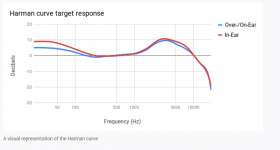
Google up "harman headphone target curve" to find more info on it.
10db peak ~3kHz, what the .. apparently ear canal resonance masks this area when using headphones so boosting makes the perceived response flat, or something like that. Need to try this, the Sonarworks version I have don't seem to have this.
To be fair the image is stolen from here https://jazztimes.com/reviews/products-and-gear/audio-files-the-harman-curve/
edit. Found database for headphone responses that seems to be free https://headphonedatabase.com/
Supposedly it gives parameters for EQ to tune your headphone model to some target curve, didn't go deep yet.
Here is the nugget https://github.com/jaakkopasanen/AutoEq , shows tips how to EQ with your device and generates the EQ curves for any program you'd like to use. Seems to use headphonedatabase.com among others to source headphone responses.

Google up "harman headphone target curve" to find more info on it.
10db peak ~3kHz, what the .. apparently ear canal resonance masks this area when using headphones so boosting makes the perceived response flat, or something like that. Need to try this, the Sonarworks version I have don't seem to have this.
To be fair the image is stolen from here https://jazztimes.com/reviews/products-and-gear/audio-files-the-harman-curve/
edit. Found database for headphone responses that seems to be free https://headphonedatabase.com/
Supposedly it gives parameters for EQ to tune your headphone model to some target curve, didn't go deep yet.
Here is the nugget https://github.com/jaakkopasanen/AutoEq , shows tips how to EQ with your device and generates the EQ curves for any program you'd like to use. Seems to use headphonedatabase.com among others to source headphone responses.
Last edited:
Etymotic in-ear earphones had such a curve for as long as I can remember. However, it never exactly matched my ear canal resonance so they always sounded a bit weird. Limited their usefulness for me.
Thanks, that is all very interesting!Hi all, it turns out headphones have their own Harman curve which looks like something like this:
View attachment 1033139
Google up "harman headphone target curve" to find more info on it.
10db peak ~3kHz, what the .. apparently ear canal resonance masks this area when using headphones so boosting makes the perceived response flat, or something like that. Need to try this, the Sonarworks version I have don't seem to have this.
To be fair the image is stolen from here https://jazztimes.com/reviews/products-and-gear/audio-files-the-harman-curve/
edit. Found database for headphone responses that seems to be free https://headphonedatabase.com/
Supposedly it gives parameters for EQ to tune your headphone model to some target curve, didn't go deep yet.
Here is the nugget https://github.com/jaakkopasanen/AutoEq , shows tips how to EQ with your device and generates the EQ curves for any program you'd like to use. Seems to use headphonedatabase.com among others to source headphone responses.
I gather that, as markw4 indicates, these things might be quite individual but still a very useful starting point to work from.
On that thought.. One of the sources suggested earlier led to this rtings link on passive soundstage rankings , which could be very useful... Except i'm not sure how much to trust it. For example, the senn HD598 gets a reasonable rating for soundstage, yet in my experience (or on the 's' suffix version, anyway) they are fairly limp in that respect (though excellent for detail and FR). Perhaps these things are just so individual that third-party tests and recommendations are of limited value.
Cheers,
Kev
Yeah, individual they can be, and the tests and reviews are very often marketing.. answer for both issues is you need to test them yourself and find a pair that you like, that are comfortable and sound good to you. If you have any headphones you could test the EQ stuff, and if it works for you then almost any headphone could sound good I guess, at least minor issues with the sound can be fixed.
Thanks. I think this adds even more weight to earlier posts, especially as my current 'phones turn out to be supposedly quite decent. I really just need to spend a lot of time playing with EQ and perhaps more sophisticated DSP to see what may be achieved. Certainly before looking to more costly 'phones etc.Yeah, individual they can be, and the tests and reviews are very often marketing.. answer for both issues is you need to test them yourself and find a pair that you like, that are comfortable and sound good to you. If you have any headphones you could test the EQ stuff, and if it works for you then almost any headphone could sound good I guess, at least minor issues with the sound can be fixed.
Some tests have shown that my laptops do vary considerably in sound quality through the same software and headphones, so i think a decent (not necessarily expensive) proper headphone amp and maybe DAC will not be a poor investment either. Maybe something second-hand off ebay temporarily, as i don't want to be rushed whilst building my own amp.
Should be quite interesting!
thanks,
kev
For me it seems very important for any sense of realism,
I just detuned my Foobar imaging DSPs for my headphones just for you. The image was narrow and stuck inside my head- it was horrible. I had to stop. Back to full DSP's and theres a delightful 3D out of head out sound stage with every instrument clearly positioned.
But its not like the soundstage 20 feet out in front from speakers. If dont want to adapt to that just ditch your headphones.
Hows the dipole speaker project plan? How about this:
1. 3 way stereo dipoles at 90 degrees to the neighbour wall for >100Hz
2. 40-100Hz bass dipole "subwoofer" directly behind your head for max local SPL and minimal SPL into the neighbour (there's another thread - check it out)
What drivers do you have? If you score a cheap old AV receiver for under fifty bucks with seven channels, it can be your multichannel DAC-amps for driving an active 3-way OB mains and OB sub.
Last edited:
Kev, if you are going to use your laptop(s) as source then I would strongly suggest to start off with a USB DAC Headphone amp combo. You can use the laptop for playing the music (FLAC files or Tidal streaming) and for the EQ or DSP software, but you have to avoid using the laptop hardware (onboard soundcard and DAC). There are so many options out there, but have a look at something like this:Some tests have shown that my laptops do vary considerably in sound quality through the same software and headphones, so i think a decent (not necessarily expensive) proper headphone amp and maybe DAC will not be a poor investment either.
https://www.audioquest.com/dacs/dragonfly/dragonfly-cobalt
https://hifimediy.com/product-category/dacs/
I used this one before I upgraded my DAC and streaming system:
https://hifimediy.com/product/hifime-android-dac-es9018k2msa9023/
It is a great sounding budget dac + amp option ideal for laptops or smartphones. I still use it with my Android phone.
@Kev06 If you decide to Invest in new stuff go to audiosciencereview.com They have nice review index, So you can very fast find some contenders in both headphone and headphone amplifier categories. There you will der that with a rew exeptions older models just dont hold up today. Actually Audiosciencerev.. has pushed the performance level of several companies by publizisining thorough measurements and thereby gotten enemies on both manufacturer and fanboys sides. Their reviews are still not always perfect, but he is open to suggestions and optimizes All the time.
Cheers!
Cheers!
@kazap I have been wanting to try your suggestions abouts using AVR as active crossover system for many years. I dont need it now since
Ive gotten a 3 way analog active filter, but one Day (in retirement?) I will try it out. Denon mostly measures very well. Some Onkyos can bridge front with some backchannels for extra power to bas drivers. Very sorry for off topic Kev. Im very bad in this way.
Che rs!
Ive gotten a 3 way analog active filter, but one Day (in retirement?) I will try it out. Denon mostly measures very well. Some Onkyos can bridge front with some backchannels for extra power to bas drivers. Very sorry for off topic Kev. Im very bad in this way.
Che rs!
go to audiosciencereview.com
They do some OK measurements but they arent scientific and they dont review audio sound so the name is misleading. Worse they have a group delusion that lab measurements are all is needed and anyone who doesn't adhere to the dogma is set upon. Most users including the site admin are pretty ignorant but make up for it with chest beating.
- Home
- Amplifiers
- Headphone Systems
- Help getting into headphone systems for serious listening

